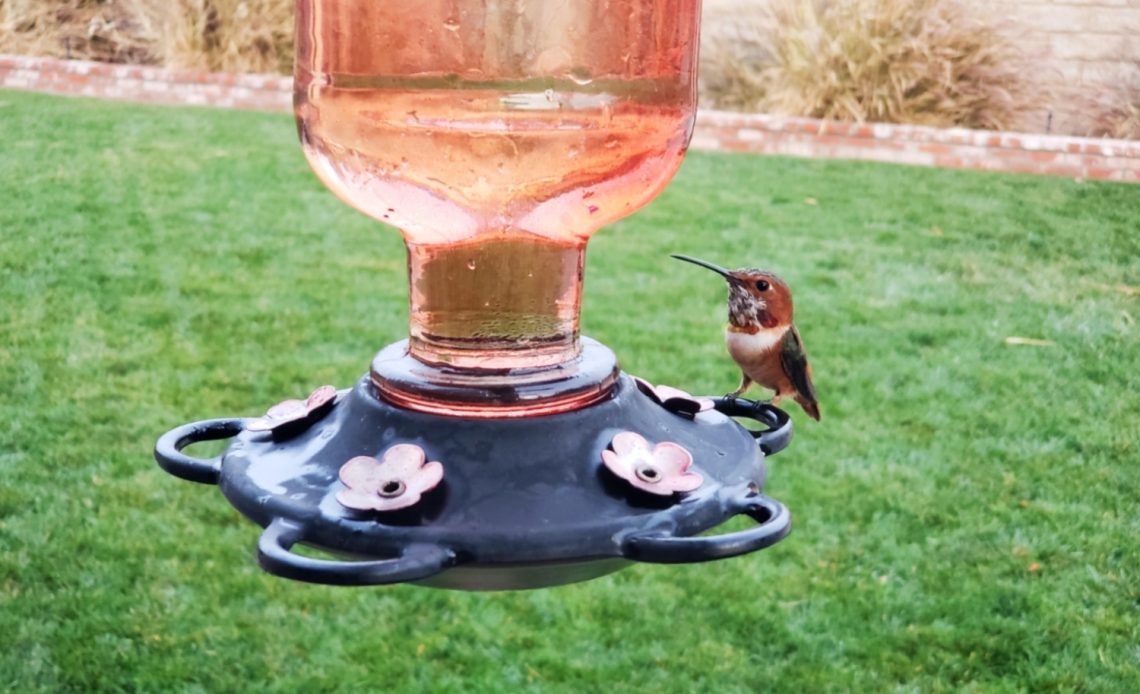

We’re here to help! Wild Yards is a completely free website that is 100% dedicated to helping you create a wildlife-friendly, sustainable yard. Read more
WildYards is reader-supported. When you buy a product through a link on our site, we may earn a comission. Every product is independently selected by our (obsessive) editors and our reviews are unbiased and objective. Read more about our mission or our privacy policy.
We always love watching critters roam through our backyard. From deer to bats to foxes, we’re always thrilled to see our local wildlife visiting our property. Sometimes, we think they enjoy our backyard gardens more than we do! Of all of the animals that we like to see, hummingbirds are among our favorites. These busy birds are always on the move! But if you notice a hummingbird sitting on a feeder for hours, you may be concerned, and wonder if that’s normal behavior.
If a hummingbird has been sitting on your feeder for hours without moving, that may be a sign that something’s wrong. If you suspect the bird is sick, remove it, place it in a shoebox lined with shredded paper, and contact a wildlife rescue for assistance.
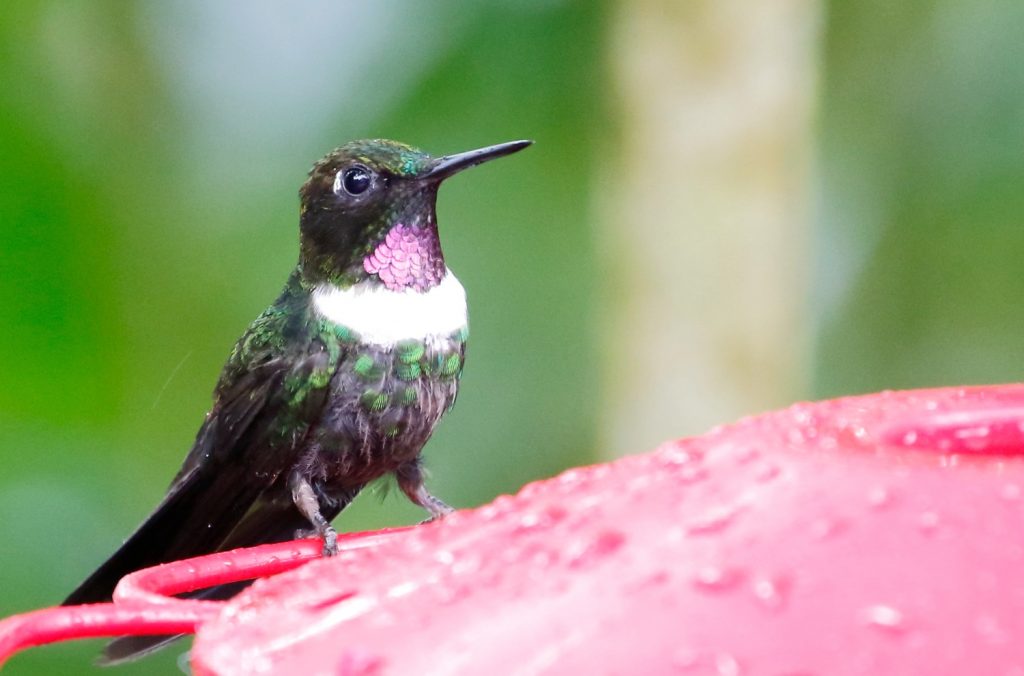
5 Reasons why hummingbirds sit on feeder for hours
It’s not necessarily abnormal to see a hummingbird sit still for hours at a time. Hummingbirds need between 8 and 16 hours of sleep every night.
What is abnormal is seeing a hummingbird sitting on a feeder for hours during the daytime without moving or interacting with other birds.
Here are a few reasons why a hummingbird might sit in the same place for a long time.
The hummingbird is exhausted
If you notice a hummingbird perched on your feeder sleeping for hours, there’s a good chance that the bird is simply exhausted.
Hummingbirds can cover astonishing distances in a short period of time.
Though tiny, a hummingbird can cross the Gulf of Mexico, a distance of around 500 miles, in less than 24 hours. Talk about impressive! So it’s no wonder that these little birds run out of gas every now and then.
Take a closer look at the hummingbird on your feeder. How does it look? If its feathers are clean and smooth, and its breathing pattern is normal, then it’s probably just resting.
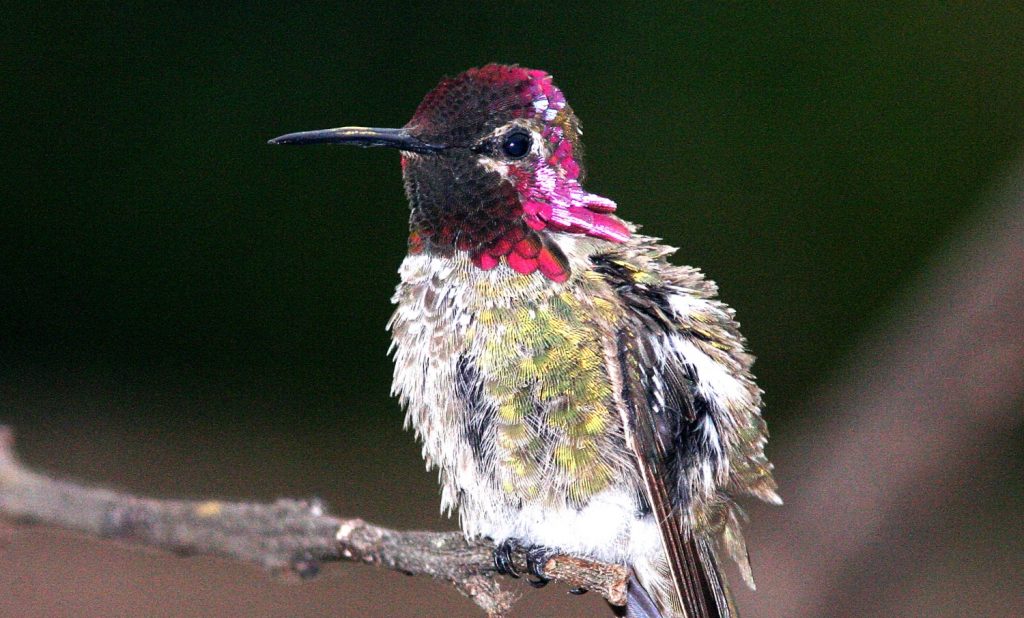
What should you do?
If you suspect the hummingbird sitting on your feeder is sleeping, but not sick, then just keep an eye on it and give the bird a chance to get some rest.
If you’re concerned for the bird’s safety — say the feeder is swarmed by wasps or other hummingbirds, or there’s a stray cat lurking nearby — then you can remove the bird from the feeder gently, and place it in a shoebox lined with shredded paper.
Set the shoebox in a safe place where it’s dimly lit and quiet. Check on the bird every 15 minutes by taking the box to an open area outdoors and opening it up. If the hummingbird has recovered, it will fly off. If not, repeat the process.
If the hummingbird has not recovered in an hour, then it’s time to get in touch with a local wildlife rescue to determine the best path forward.
The hummingbird is in torpor
If you see a hummingbird perched at your feeder that appears to be sleeping upside down like a bat, don’t be alarmed. The bird is simply in torpor.
Torpor is a state in which an animal, be it a hummingbird or a box turtle, has slowed its metabolism. It’s not quite sleep, but it’s not quite hibernation, either.
Hummingbirds all across the United States will slip into torpor when the temperature drops below 50 degrees Fahrenheit at night. But hummingbirds have also been known to go into torpor on hot days, too.
When hummingbirds go into torpor, their feet clamp tightly around their perch. Even though they may fall asleep right side up, they can slip as they sleep and end up upside-down.
Hummingbirds go into torpor to conserve energy, regulate their body temperature, and slow their heartbeat. Torpor usually lasts anywhere from 20 minutes to an hour.
What should you do?
Nothing! If the hummingbird on your feeder is in torpor, then the best thing you can do is leave it alone.
Hummingbirds go into torpor to recover from extensive trips and to survive extreme temperatures. Hanging upside down makes it easier for them to slow their metabolisms.
It can be startling to see a hummingbird dangling upside down from your feeder, but it’s actually a pretty common occurrence and nothing to be too worried about.
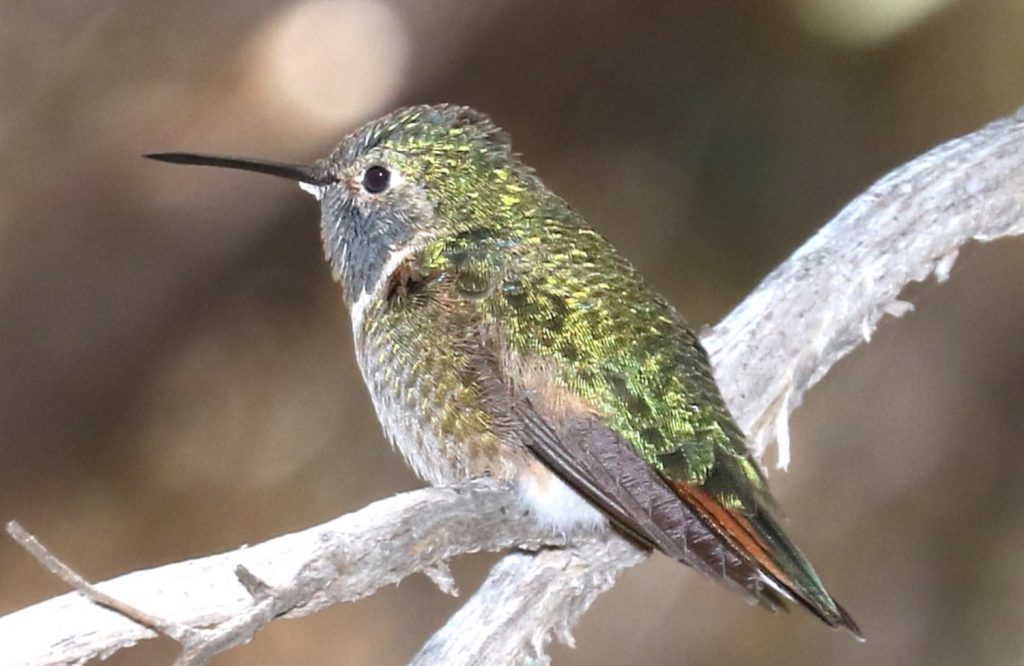
The hummingbird is guarding its food source
Some more aggressive hummingbirds, usually males, will sleep at perch feeders that they have decided belong to them. The reason they do so is simply so they can protect their food source from other hummingbirds.
Hummingbirds may take a break on your feeder to digest their food. They’re more likely to rest on feeders that are under a cover, like a porch or gazebo, because they can be near their food and out of the weather.
If you see a hummingbird sitting on a feeder for a long period of time, but it appears to be otherwise healthy, and occasionally wakes up to defend the feeder from bees, wasps, and other hummingbirds, then you can be certain the hummingbird is simply trying to protect its food source.
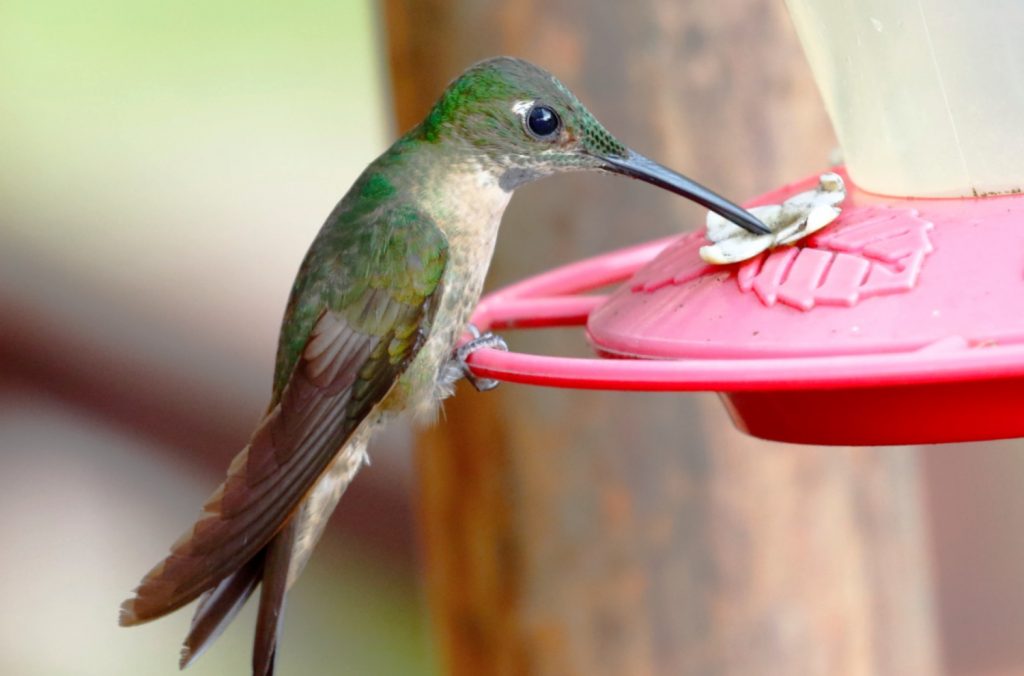
What should you do?
If the sleeping hummingbird is burning the candle at both ends trying to protect its feeder, try installing a few more feeders so there’s plenty of homemade nectar to go around.
The more food options are available, the less the hummingbird will feel like it has to defend its nectar.
We also suggest planting a variety of hummingbird-approved flowers. This provides hummingbirds with plenty of feeding opportunities, and encourages them to visit your property as often as possible — and build their nests nearby!
The hummingbird is sick
When you notice that a hummingbird has been sitting in one place for a while, it’s important to take a closer look.
If you notice irregular breathing, an open beak, unkempt feathers, or other sick hummingbird behaviors, that’s a major red flag.
Other signs that the hummingbird on your feeder is unhealthy include plumage loss. You may see bare spots, or, in some cases, bugs crawling over the bird.
What should you do?
The average birdwatcher just isn’t equipped to deal with a sick hummingbird. And, the fact is that sick hummingbirds can be very difficult to care for, even in the best of circumstances, simply because of the hummingbird’s delicate nature.
If you suspect the hummingbird sitting on your feeder is sick, contact a wildlife rescue immediately.
They will be able to advise you as to which illness(es) the bird may be suffering from, and what you can do to help.
They may even come to your house and pick the bird up so they can treat it, rehabilitate it, and release it back into the wild.
In the meantime, you can help the sick hummingbird by ensuring your feeders are clean and filled with fresh hummingbird food.
Clean your feeders weekly with soap and boiling water to kill pathogens and prevent the transmission of potentially deadly diseases.
Replace the water in your hummingbird feeders every 3 to 4 days, or even more frequently in warm weather. If the water smells funny, it’s time to pour it out, clean the feeders, and start over.
And be sure to use only plain white sugar in your homemade hummingbird nectar recipe. Honey, molasses, and other sweeteners can encourage the development of harmful bacteria, putting your local hummingbird population at risk of getting sick.
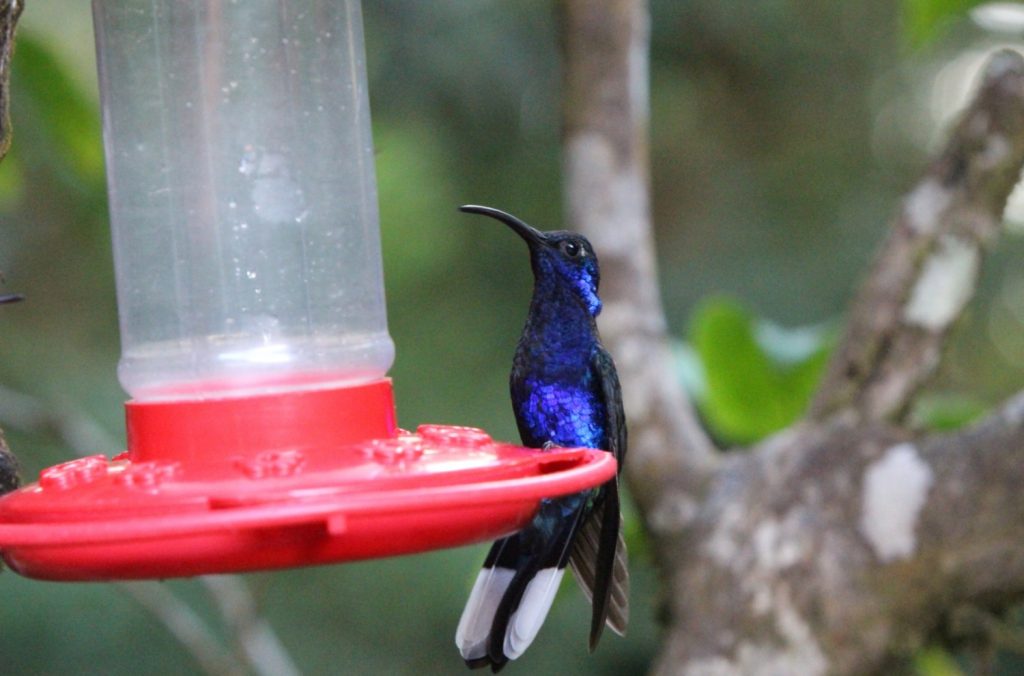
The hummingbird is hurt
If the hummingbird in question doesn’t appear to be sick but is holding itself in an awkward position, then it may be injured.
Hummingbirds may collide with each other in midair during a chase, and fledglings often fly into their own reflections in windows.
Sometimes, hummingbirds get into close calls with predators, like cats, which can leave them hurt as well.
Take a closer look at the hummingbird sitting on your feeder to check for signs of injury.
The bird may have ruffled feathers on its head or one side of its body. It may have scratches on it, or it may be holding its wing(s) at an awkward angle.
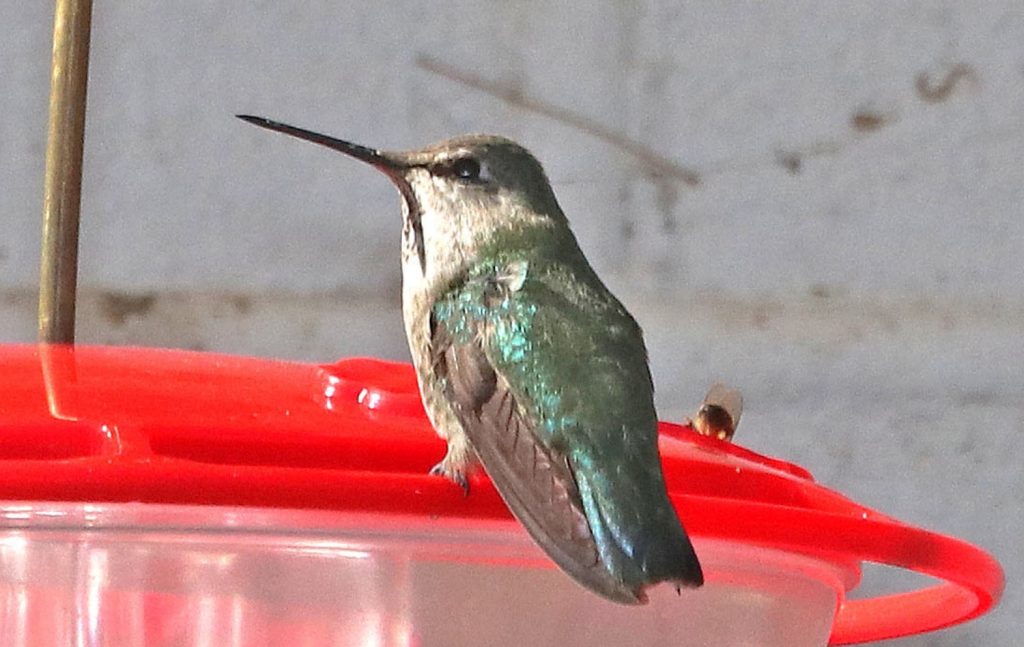
What should you do?
If you suspect a hummingbird is injured, contact a wildlife rescue immediately. In some cases, small animal vets can provide assistance as well.
If the hummingbird is injured, and you fear for its safety, remove the bird from the feeder and place it in a shoebox in a quiet, calm place until you can get it some help.
What can you do to support your local hummingbirds?
In addition to keeping your feeders clean, you can also help keep your hummingbirds healthy by placing decals on your windows and other reflective surfaces, so they don’t fly into them and get hurt.
Bringing outside cats indoors is also a good idea, that way they can’t snack on your flying friends.
If you haven’t already, install a bird bath, and invest in a solar-powered fountain to put in it. Hummingbirds love to play in running water!
Planting native flowers will give your local hummingbirds plenty of food to enjoy, and leaving a shallow dish of grape jelly, orange slices, and fresh watermelon will also attract their attention.
Lastly, install clip-on nesting sites and wire nesting material holders to encourage your local hummingbirds to take up residence in your backyard.
If you notice a hummingbird sitting on your feeder for hours, pay close attention. With the right care, you can help the bird get back to normal so it can continue to grace your backyard with its presence.
